The Niagara Falls. There's nothing quite like it in the entire world. This natural wonder is one of North America's proudest treasures, and its beauty has been the subject of books, myths, and love stories since the 17th century. Today, over 300 years after its discovery, it continues to impress us with raw power and magnificence.
But there's more to the Niagara Falls than what meets the eye. During the last century, the natural wonder has been the subject of historical industrial work, the site of never-before-seen engineering feats, the stage of remarkable adventurers, and the holder of some dark, gruesome secrets.
1969: Doing The Unimaginable
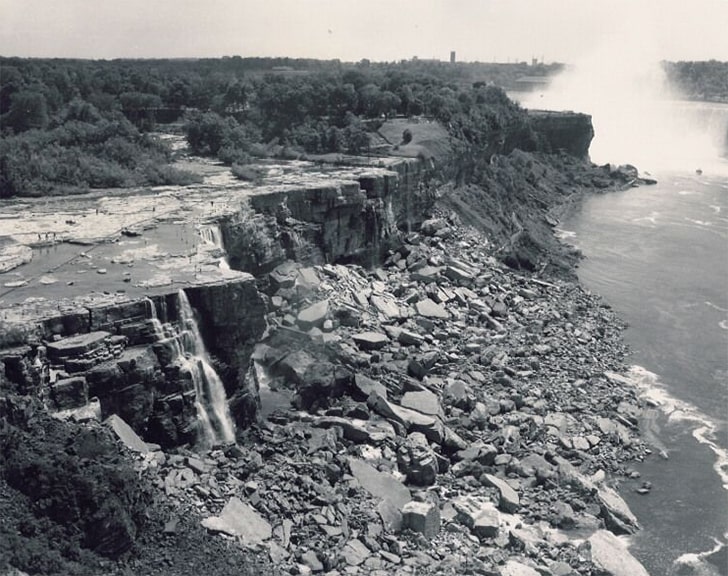
When we look at the glorious Niagara Falls today, it's hard to imagine that the seemingly unstoppable flow of water was once suspended. It all started in 1969, back when a team of engineers drained the whole site! Their goal? To take a look at what was happening underneath the water.
As you can imagine, the engineers' effort was not only tremendous but also very costly. But with the help of science and technology, they were able to achieve the impossible: getting most of the water out of the Falls. What they discovered was dreadful and unimaginable secrets.
A Site of Magical Beauty
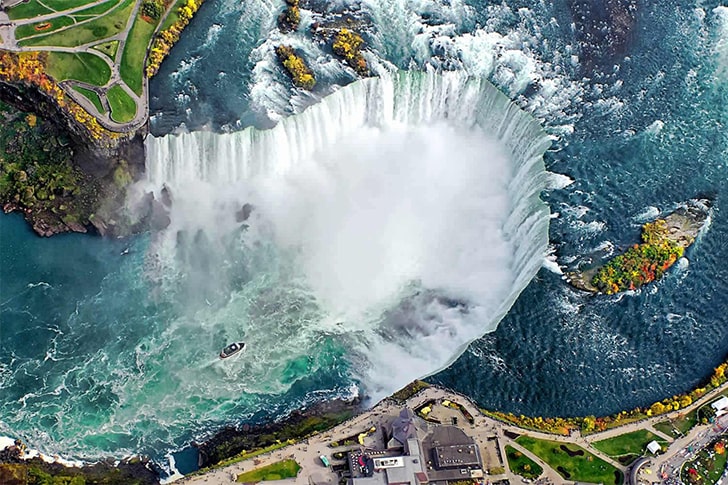
One of the most popular tourist attractions in the world, Niagara Falls was always a fine example of Nature's uncanny beauty and force. But even the most beautiful things in life can hold a dark and horrific secret.
Nearly six decades ago, nobody could have guessed that one of Mother Nature's proudest symbols could have ever been stopped by man. The site was considered a natural wonder ever since the day it was first spotted by Europeans exploring America's wild continent. But, as it always happens, the true mysteries were about to be revealed.
When Mother Nature Was Suspended
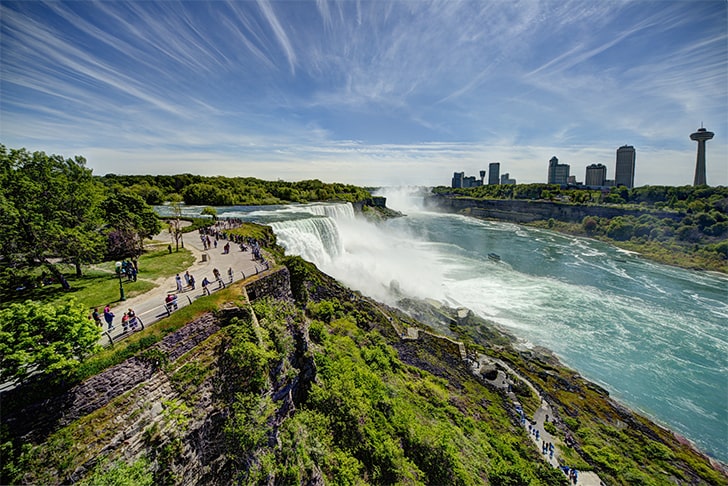
If there ever was a year in which man showed superiority over nature, that was 1969! While counter-culture movements rose all over the country, the Americans were busy putting the first man on the moon. And if conquering space is extremely impressive, stopping the mighty Niagara Falls doesn't fall far behind.
When the water of the Falls suddenly stopped running, people stopped in awe of the unlimited power of human engineering. It was a big surprise, even for the people of the country responsible for inventing the A-Bomb and hoisting a flag on the moon. But the surprises were not over just yet...
Older Than America Itself
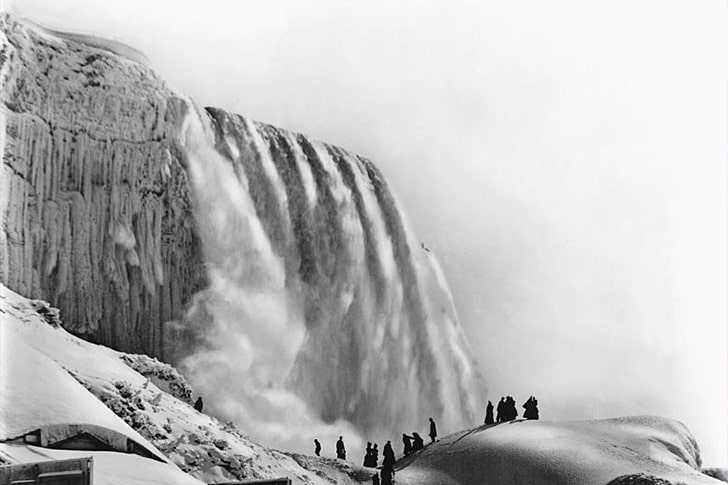
The story of the Niagara Falls dates as back as 18,000 years. It started with the end of the Wisconsin glaciation, the final ice age of the North-American continent. With a lot of newly-melted water forming the Great Lakes, it was only a matter of time until the brutal water curse reached its final destination.
As we all know, water doesn't rest until it finds its way into the ocean. Trying to reach the Atlantic Ocean, the torrent from the Great Lakes carved a massive path through the Niagara Escarpment. Throughout time, the course of water carved the cliffs that are now known as the Niagara Falls.
An Indigenous Wonder At First?
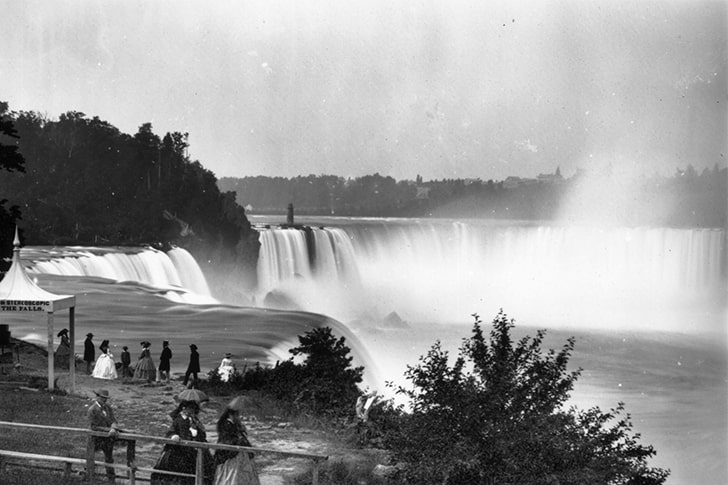
Before being spotted and registered by European explorers in the 17th century, the Niagara Falls was most likely already known by the indigenous people. Although there are no written records to support this claim, few people believe that the original communities inhabiting the American border could've missed such a spectacular place.
Some sources claim that the local tribe of the Onguiaahra was the inspiration behind the name 'Niagara'. The region was dominated by two opposing native tribes, known as the Huron's and the Iroquois. A Native American Iroquois tribe known as the Atiquandarok may have been the first to ever settle in the area.
Recorded By the French
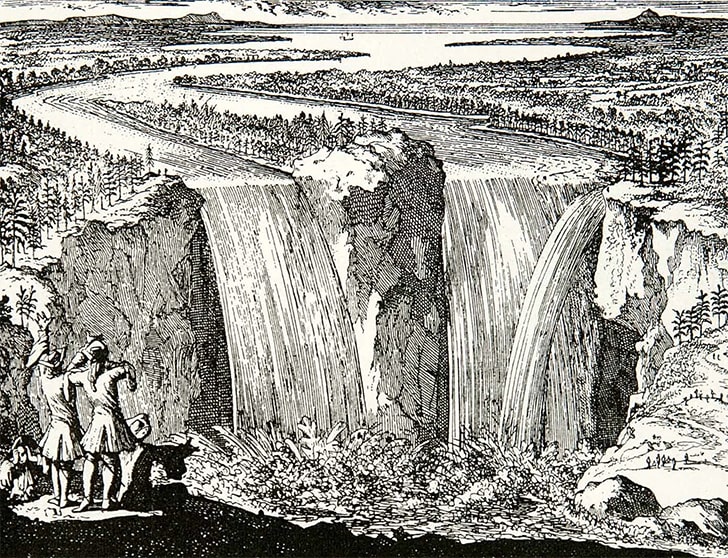
The first reports of the Niagara Falls were made by a French explorer called Samuel de Champlain, at the beginning of the 17th century. But it took until 1678 for the first Western adventurers to actually set foot on the region. The first Westerners who have ever contemplated the Falls were the men of the New France expedition.
The New France expedition was led by a priest. Father Louis Hennepin was a Belgian Roman Catholic clergyman and one of the first persons to explore and record the North American interior. The Niagara Falls was introduced to the Europeans in 1683, with the release of Hennepin's book A New Discovery.
A Waterfall Unlike Any Other

An impressive sight even today, the Niagara Falls caused a strong impact on Father Louis Hennepin. He described it as an "incredible cataract", "which has no equal". In his historic accounts, he mentioned that while similar natural formations could be found in Italy, the Niagara Falls met no parallel in the universe.
He was right. His descriptions of the Falls were so evocative that the region was visited by other great French explorers in the following years. Amongst the very first witnesses of its sublime beauty was the soldier Henry De Tonty, the Baron of Lahontan, and the Jesuit historian Pierre de Charlevoix.
A 200-Year-Old Tourist Attraction
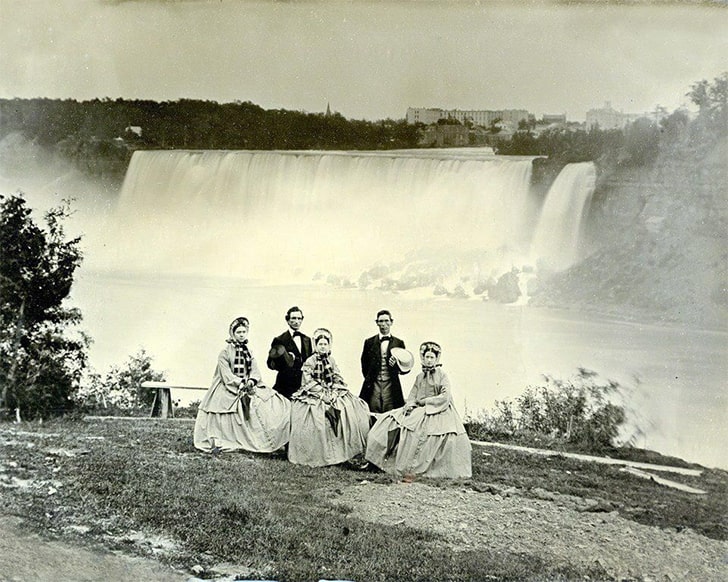
Soon enough, the Niagara Falls was no longer a hidden secret, destined only to the most adventurous French explorers. At the beginning of the 19th century, the expansion of roads and railroads in North America allowed the influx of visitors who were enjoying the site in their free time. In other words, tourists.
Soon enough, the Niagara Falls became a tourist attraction, especially popular amongst newly-wed couples. The area started seeing the appearance of its first hotels and inns. But from early on, the Americans knew that the economical potential of the Falls wasn't just limited to the booming tourist industry.
Power is Money
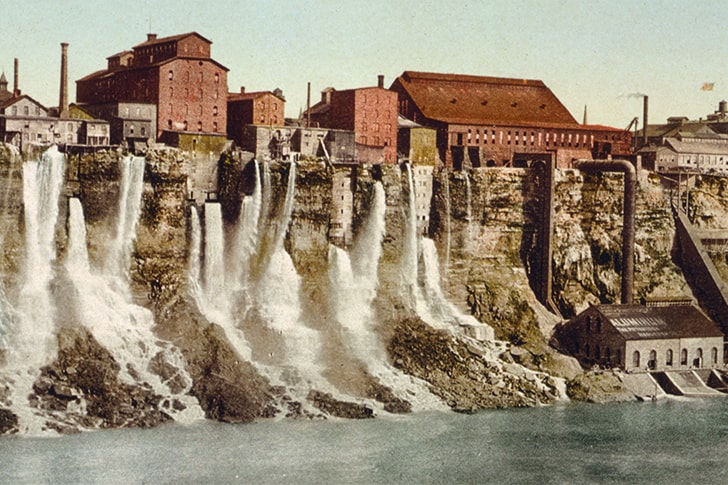
Men are very skilled at making the most out of nature's bewildering power. We did it with cattle, with horses, and with windmills. And even before the start of the 20th century, we also did it with the Niagara Falls. Not letting that massive water flow go to waste, a hydroelectric generating station was built.
In 1895, this impressive construction was inaugurated. At the time, it was the world's largest hydroelectric generating station. The station fueled the neighboring city and factories for decades, pioneering the many other hydroelectric constructions that were made in the region during the following century.
Nikola Tesla Steps In

The memorable Serbian-American inventor Nikola Tesla also played his part in the Niagara Falls history. In 1896, only one year after the inauguration of the hydroelectric station, he decided to use his scientific knowledge to take the station to a whole other level.
The station was only able to carry electricity for about 300 feet. But this serious limitation was quickly fixed by Tesla. After studying the river's current, he devised an engineering plan that allowed the electricity to travel more than 20 miles. Soon enough, Niagara's power was able to reach the booming city of Buffalo, in New York.
A World-Shaping Invention
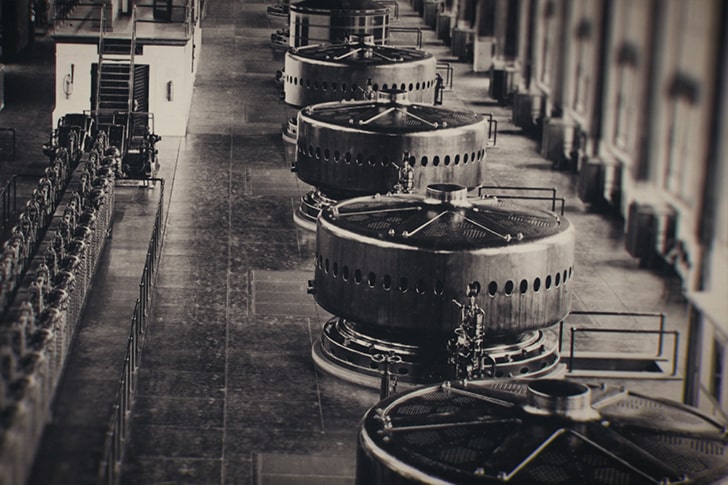
If Tesla was the mind behind the invention of the alternating current induction motor, the Niagara Falls was the inspiration behind it. The AC induction motor revolutionized the way electricity worked and contributed to the rapid industrial expansion of the United States. By allowing electricity to flow in two directions instead of just one, Tesla made it possible for electric power to be distributed to far-away cities.
This remarkable invention was first applied in the Niagara Falls' station and helped to shape the America we all know. Today, the Falls still generate electricity, with over 2.4 million kilowatts of power being produced by the flowing water.
A North-American Symbol
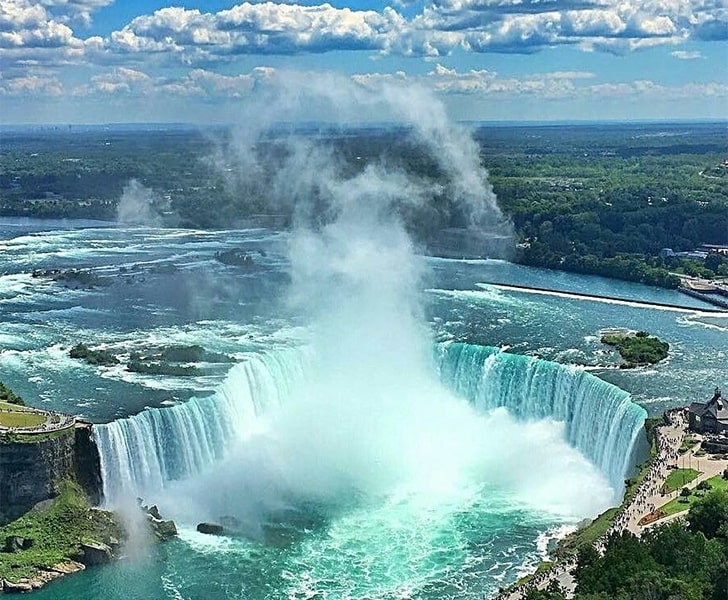
Even though the Niagara Falls played a decisive part in the economical expansion of the United States, the natural wonder is a North-American symbol. Sitting at the border between New York and the Canadian state of Ontario, the Falls are far from being the landmark of just one nation.
Every year, 30 million tourists rush in to see the spectacle of the ever-pouring water. It's one of those places everyone should visit at least once during their lives. And in the end, the Falls are not solely American and Canadian. They belong to the natural world and are destined for the whole of humanity to contemplate.
The Night Shift
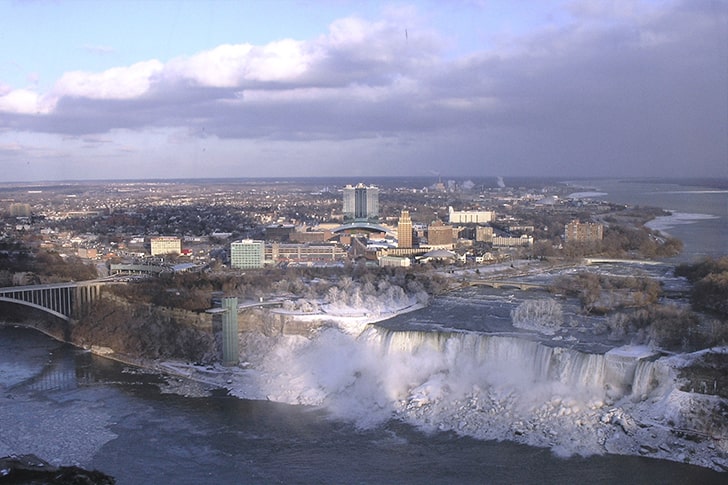
Can a place like the Niagara Falls be simultaneously utilized for tourism and electricity? To this day, there have been no compatibility problems, but the Falls are interestingly forced to work a 'night shift'. It all started with a treaty signed in 1950.
To preserve the imposing water-flow for the tourists, the local companies are allowed to divert more water into their plants at night time. This means that daytime visitors will not be affected by the hydroelectric exploration of the Falls, which can sometimes result in a diminution of the water volume.
Does Water Flow Ever Stop?
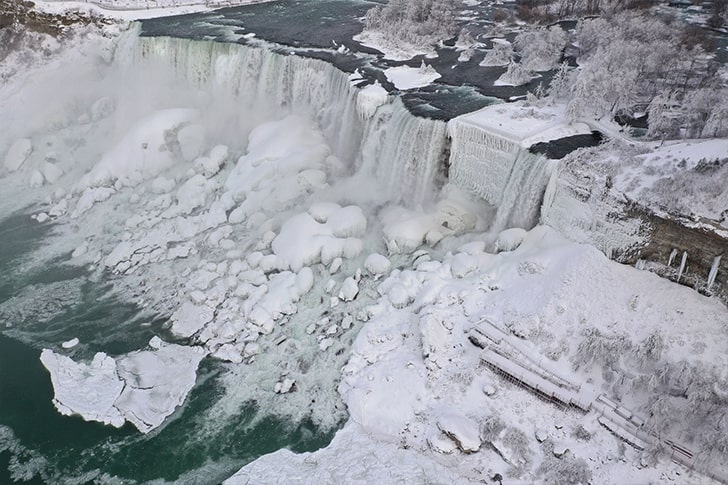
The water flow of some waterfalls is known to stop during some periods. But in a massive waterfall like the Niagara Falls, experts have assured that the flow of water is always continuous. Even when, like in 2019, cold temperatures turned the tourist attraction into an almost unrecognizable sight.
While the cold Winter has a heavy impact on the tourist potential of the Falls, the hydroelectric plants continue to work and distribute power. This means that the Falls are a highly reliable source of energy, able to resist even during the year's coldest months.
There Are 3 Different Waterfalls
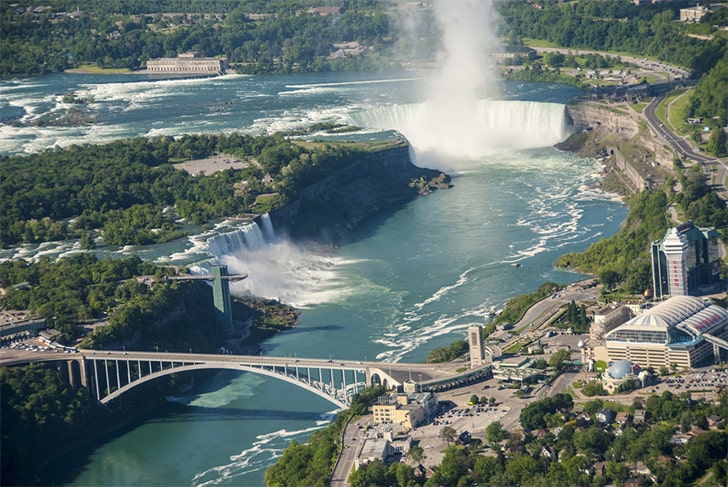
The existence of three different waterfalls in the region is clearly visible, but not everyone is aware of this fact. While the Niagara Falls are portrayed as one single landmark, the tourist attraction is made of three distinctive cliffs: the Horseshoe Falls, the American Falls, and the Bridal Veil Falls.
The first is located at the Canadian-American border and got its name due to his horseshoe-resembling shape. The other two are exclusively located on the American side. The Bridal Veil Falls is the smallest and sits right above the Cave of the Winds, a popular tourist attraction that connects to the neighboring Goat and Luna Islands.
A Threat On the Horizon?
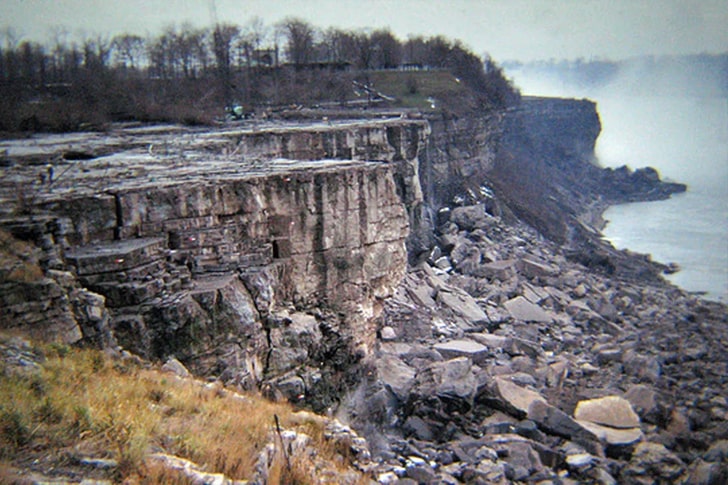
In 1965, the unthinkable started to happen. After centuries of undisturbed water flowing, time was finally starting to take its toll on the majestic Niagara Falls. The accumulation of a high volume of talus (rocks) at the base of the waterfall was causing some severe problems. The worst? The Niagara Falls were starting to become aesthetically unappealing.
Suddenly, one of the world's most popular tourist attractions started looking nothing like the postcards promised. This could have some major consequences to the local economy, and threaten the natural beauty of the Falls in the long run.
The People Demanded Action
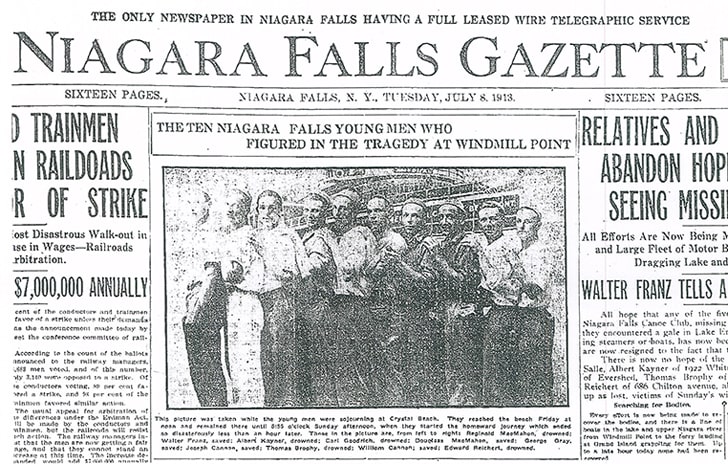
The Niagara Falls talus issue eventually became public. The turning point was an article published by the Niagara Falls Gazette, in which journalist Cliff Spiegler explained that the consistent erosion and accumulation of talus could eventually lead to the eradication of the natural wonder.
For the local population, there was nothing more important than preserving the Falls. The tourist attraction was not only the pride of the region, but it was also responsible for putting food on the table of thousands of families. Soon enough, the people of New York and Ontario started demanding a solution.
The Niagara Falls Clean-Up
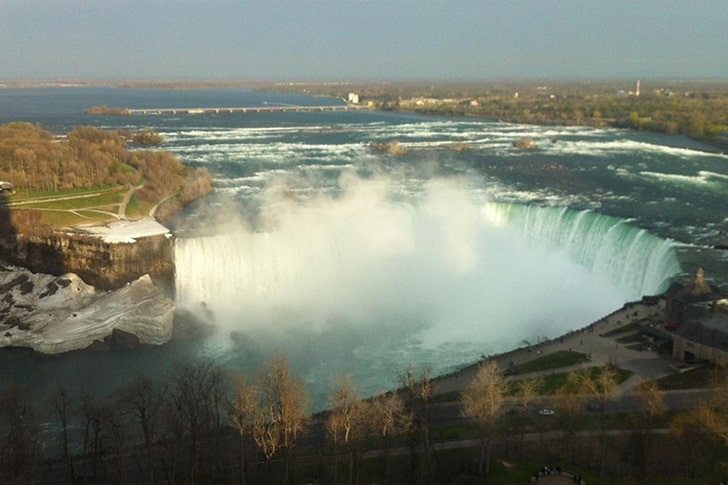
Fixing the long-term erosion issue at the Falls was the sort of operation that required a lot of patience, a lot of planning, and a lot of scientific knowledge. To deal with the problem, an international commission known as the International Joint Commission (IJC) was put together.
But while the IJC was looking for an answer, the people of Ontario and New York decided to play their part. In a massive operation launched by combined efforts of the American and Canadian governments, the clean-up of the Niagara Falls was set on motion.
Taming the Beast
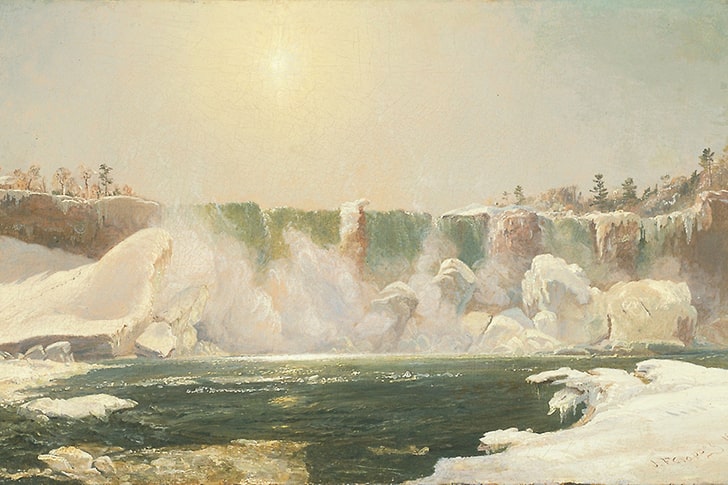
It became evident that it would be impossible to clean the Falls without first taming its relentless power. Over the years, a lot of trash and debris had piled up in the rocky surfaces of the Falls. But taking it all out while maintaining the current flow was simply not possible.
To ensure the safety of the workers and to gather further information about the Falls, the Water Control Dam opened its gates. A massive amount of water rushed through the cliffs, much to the satisfaction of the electrical facilities. The temporary flow of excessive water ended up having the desired effect. After the initial torrent, the river started to recede.
Ready to Get Clean
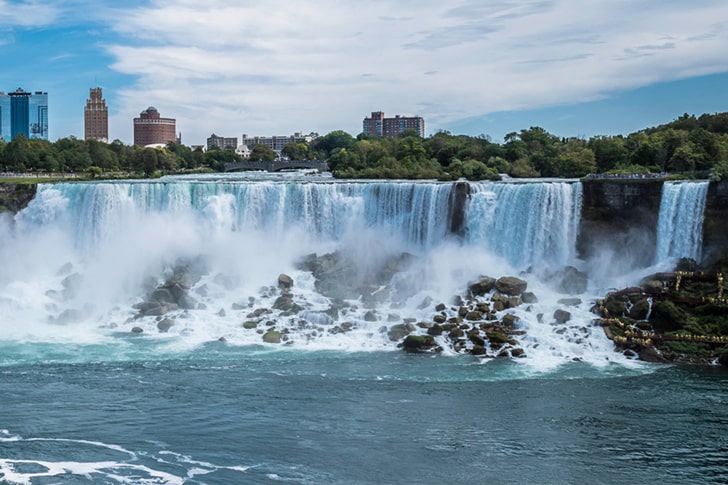
Soon enough, the ever-pouring 60,000 gallons of water per second turned into just 15,000. For the first time ever, it became possible to walk through the rocky grounds of the Falls, and the opportunity was not missed. Thousands of workers were gathered to collect trash and debris, and the U.S. officials stepped in to take a closer look at what was going on underneath all that water.
The Army Corps of Engineers (USACE) was called on the site to evaluate the conditions of the exposed river bed. Just like a patient in a surgery bed, the Niagara Falls was open and ready for a full check-up.
6 Very Intense Hours
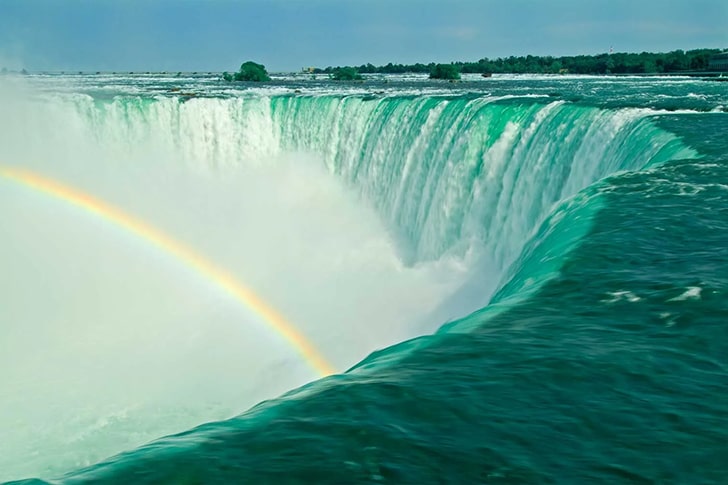
In a mere six hours, the USACE and the brave workers of the Ontario and New York regions did the best they could to clean and evaluate the river bed. Aerial photos of the site were taken, and the video recordings of the clean-up can still be found on YouTube today.
Six hours doesn't seem like much, especially when compared to the 18,000 years of history of the Niagara Falls. But it was enough to gather the necessary information to set an even more ambitious plan in motion. Step one was completed, but the Falls still needed saving.
An Even Harder Task in Hands
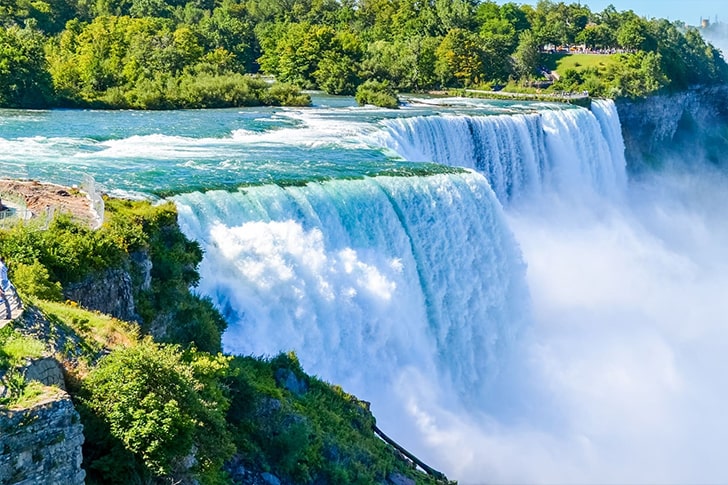
It didn't take too long for the IJC to realize that six hours were not enough to save the Falls. Getting rid of the debris and gathering information was essential, but to fix the erosion issue, a never-seen-before approach was needed. They had to find a way of completely stopping the water flow.
Managing to tame the American Falls for six hours was already an engineering feat. But was completely emptying the site of water even possible? Eventually, the task was given to the USACE, and the engineers of the Army quickly realized that an ambitious infrastructure was necessary to carry on with their mission.
A Cofferdam to Save the Day
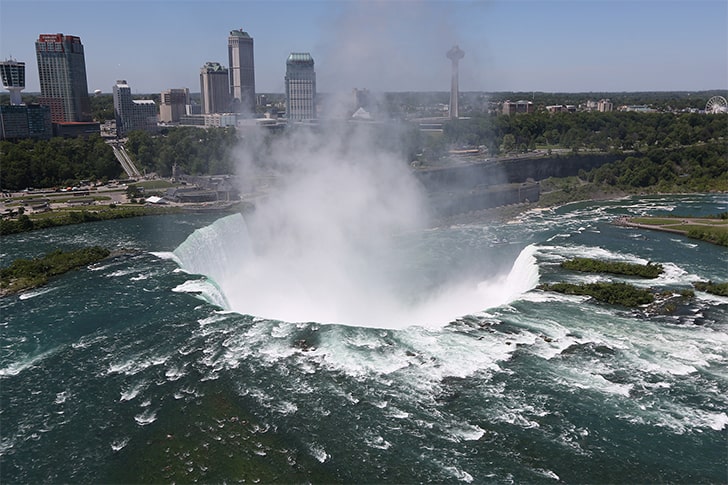
While the USACE was tasked with a mission worthy of an outrageous movie plot, they were fortunate to count on the support of one of the world's wealthiest governments. Money wasn't an issue, so it became clear that the only way to stop the water flow was to build a temporary cofferdam.
According to their calculations, a cofferdam would offer the necessary structural resources to empty the river bed and allow the scientists to work on fixing the erosion issue. But building the cofferdam wasn't going to be easy, as we will see next.
What is a Cofferdam?
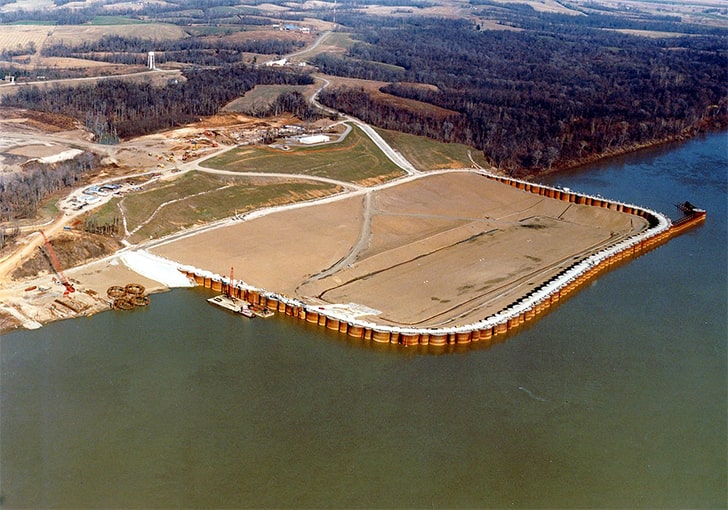
A cofferdam is a structure designed to enclose a large body of water and gather the necessary conditions to pump out that same water. It's basically a way of getting water out of a river or lake, by redirecting it to a diversion tunnel or channel.
Cofferdams are very common, especially in construction projects involving great masses of water, like bridges or actual dams. Normally, cofferdams are temporary and designed to be removed after meeting their purpose. Cofferdams are most commonly used in the construction of locks, harbors, and ship repair.
Who Was Going to Do It?
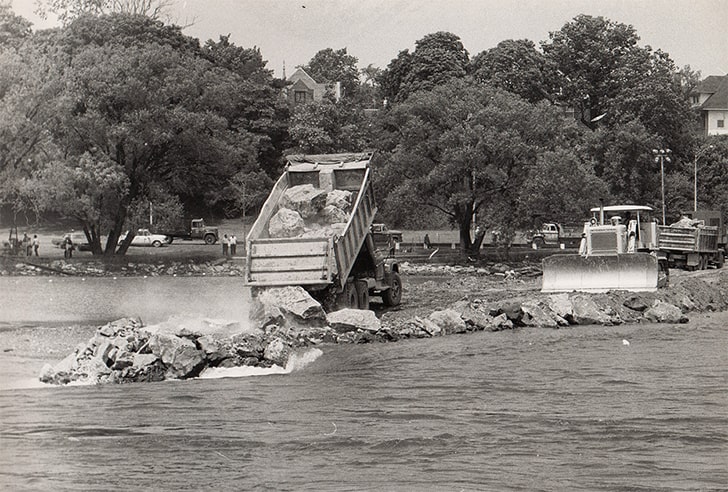
While cofferdams are pretty common, the high volume of water of the Niagara Falls demanded an especially large coffer. At this point, the staff of the USACE had done all they could. It was time to get a construction company aboard.
The chosen team was the Alberta Elia Construction Company. For their rightful place in American history and all their hard work, they were handed a half-a-million-dollar contract. It may not seem like much today, but in 1960's America it was equivalent to almost $4 million! However, was it really worth the massive risk?
They Also Had to Take Care of the Riverbed
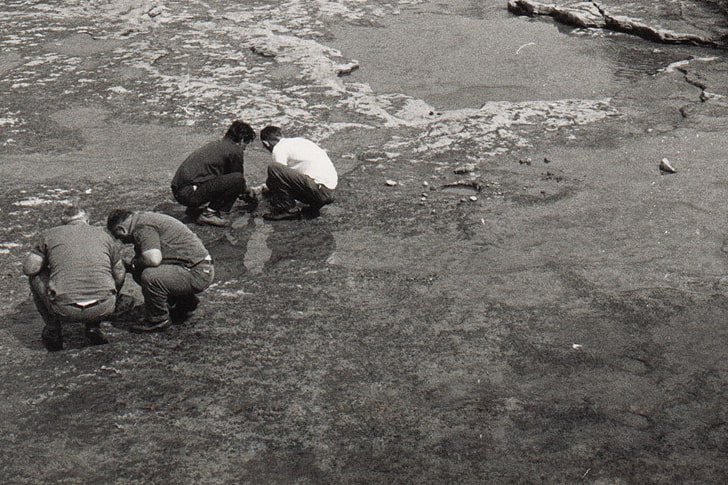
If building a massive and risky cofferdam wasn't enough, the workers of the Albert Elia Construction Company were also tasked with an additional set of instructions. They should scour the riverbed as soon as it was exposed, and also pay attention to any loose boulders, which should be removed.
Besides carrying giant rocks away from the source, the workers were also responsible for introducing a sprinkler system that was meant to keep the rock moist during the process. All of a sudden, $4 million started to sound like it was a bit of a bargain!
A Different Summer of '69
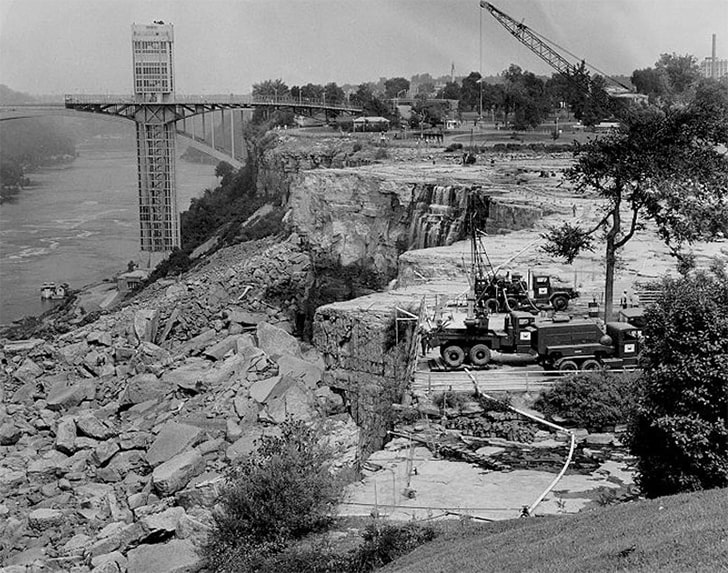
In the now-notorious Summer of '69, the Niagara Falls cofferdam started to take shape. But while thousands of Americans were out having the time of their lives, the Albert Elia workers were facing death daily. In the early days of the construction, safety conditions were particularly harsh.
If a worker happened to fall down, nothing was stopping him from meeting a tragic end in the Niagara cliffs. This eventually led to the installation of a lifeline connecting Goat Island to the mainland. It increased safety significantly, but the workers were still subjected to life-threatening risks.
On The Right Track
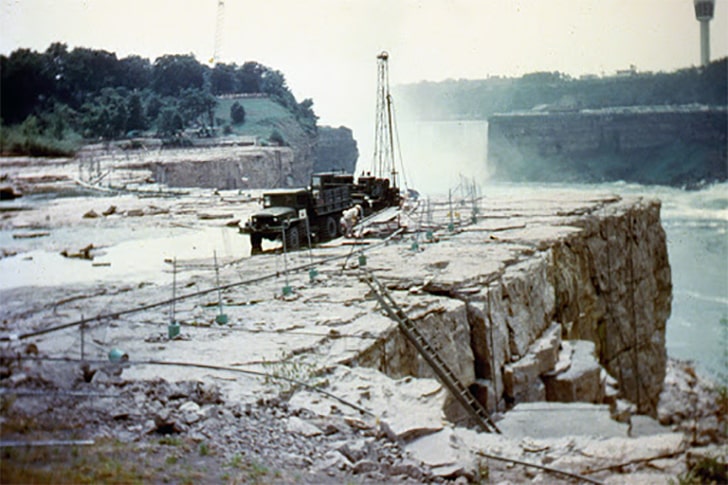
Unbelievably, the construction of the American Falls' cofferdam registered no tragic accidents. The lifeline was reportedly never used, and the brave workers of the Albert Elia Construction Company were showing results after only three days.
Although they were fighting against the forces of nature, they were working to preserve it. Is it possible that the Niagara Falls have blessed these brave men with good fortune? The truth is that, by sheer chance or relentless professionalism, the cofferdam builders were able to carry on with their plan and deliver everything they had promised without losing their lives in the process.
Tons of New Material
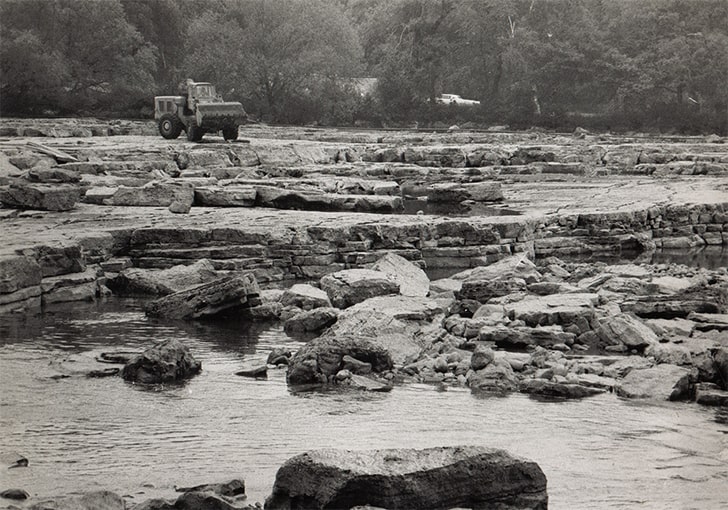
Emptying the American Falls wasn't just about building the cofferdam, but also about getting tons of new material in the upstream of the cataract. In total, it's estimated that 28,000 tons were dumped by the construction workers, involving over 1,000 trucks carrying earth and rocks.
Without these materials, it would've been impossible to even make the cofferdam. The whole process was a logistical nightmare of uncanny magnitude. But the Albert Elia workers pulled through and played their part in the saving of the Niagara Falls. Was the plan going to work?
They Did It!
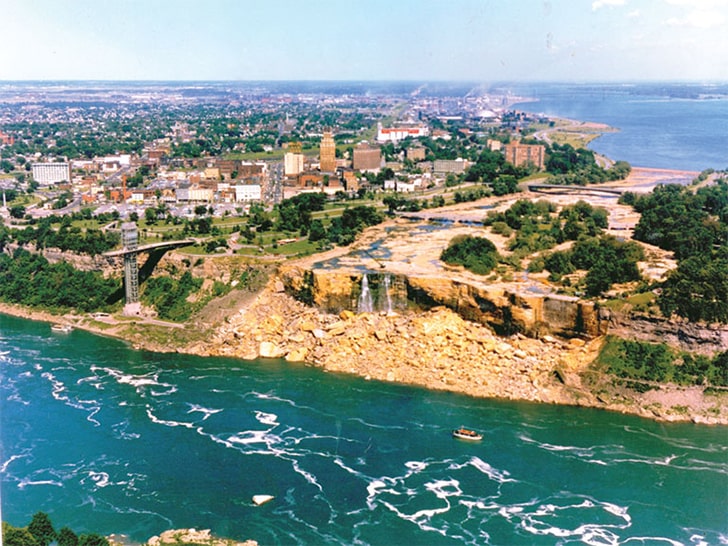
On June 12, 1969, the plan of the government to complete the cofferdam was finalized. Due to the man-made engineering feat, the water flow of the Niagara Falls stopped completely. It was a sight never seen before in the Canadian-American border.
For the first time in tens of thousands of years, the Falls were reduced to a dry pile of rocks. It seemed like a victory of man over nature. But it was all made to preserve and protect the natural world. This time, unlike what happened in the 1966 attempt to drain the Falls, there was absolutely no water passing through the riverbed.
There Was Anxiety Amongst the Locals
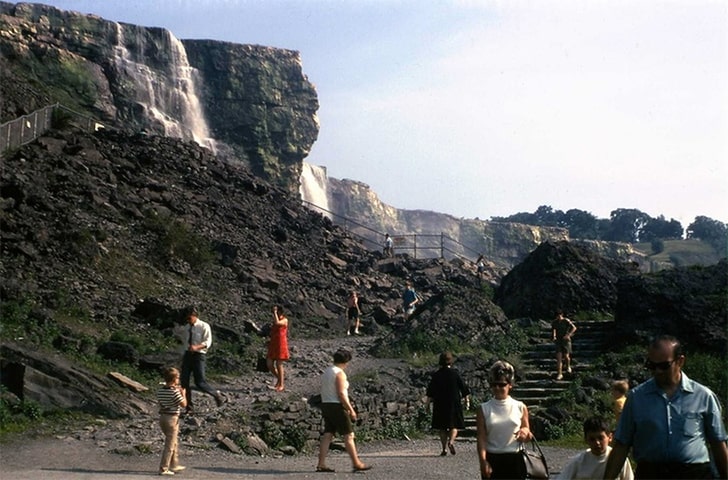
When you live close to Niagara Falls, the natural wonder plays a huge part in your day-to-day life. Seeing the cliffs of the American Falls reduced to a pile of dirt, the local population worried. Many of the people living in the city relied on tourism to get food on the table. Was this going to affect them?
While many believed that the drainage of the Falls would have massive economical consequences, the most optimistic locals thought it could actually help the region's tourism. It was Summer after all, and people were given a once-in-a-lifetime opportunity to see the mighty Niagara Falls completely dried out.
All For a Good Cause
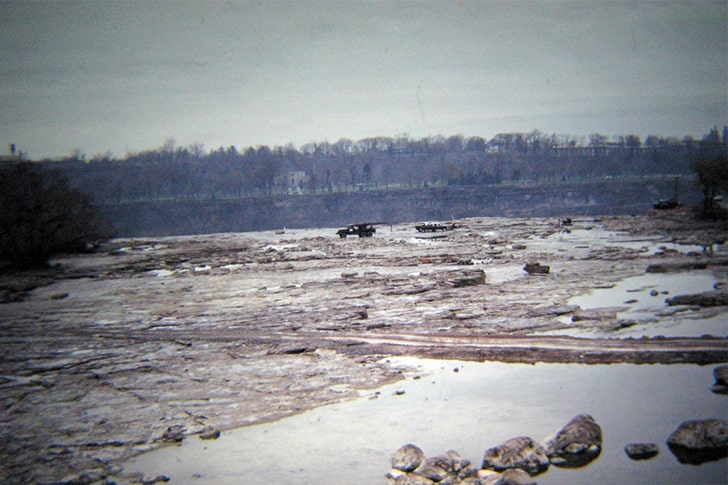
Unfortunately, the positive-minded locals were wrong. Tourism was impacted in that Summer of '69 and the number of visitors declined considerably. But it was all for a good cause. Preserving the long-term survival of the Falls was more important than guaranteeing a few good months of profitable tourist activity.
Additionally, the drying of the Falls provided an unforgettable vacation for the tourists who still decided to visit. They were able to walk freely through the American Falls cliffs, and many even gathered some lost coins. A symbolic souvenir to remember the historical taming of one of America's most relentless forces of nature.
Plenty to Look At
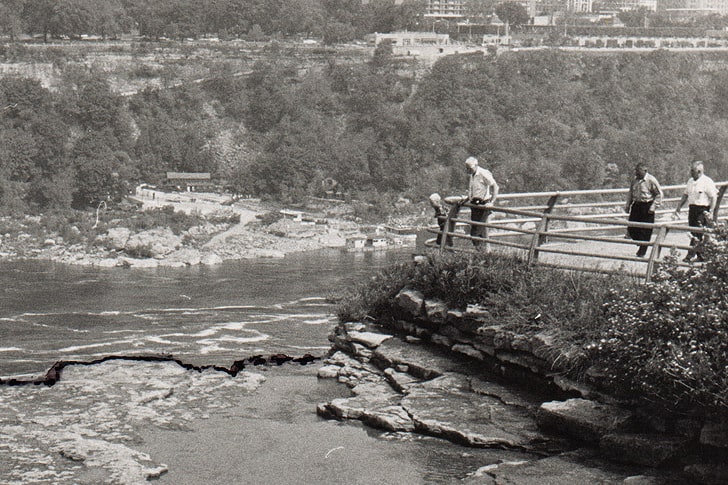
For a brief period, the Niagara Falls was closed for business. But curious visitors were still common in the site. It wasn't the usual newly-wed romantics or family expeditions, but rather the men and women of the region, who wanted to take a closer look at the once-mighty Falls.
The building of the cofferdam and the drying of the river was such an epic feat that we're still talking about it today. Can you imagine how it must've felt to the locals? It's no surprise that many people loved to stand as close to the edge as possible, with some unauthorized adventurers even jumping to the riverbed.
A Gruesome Secret
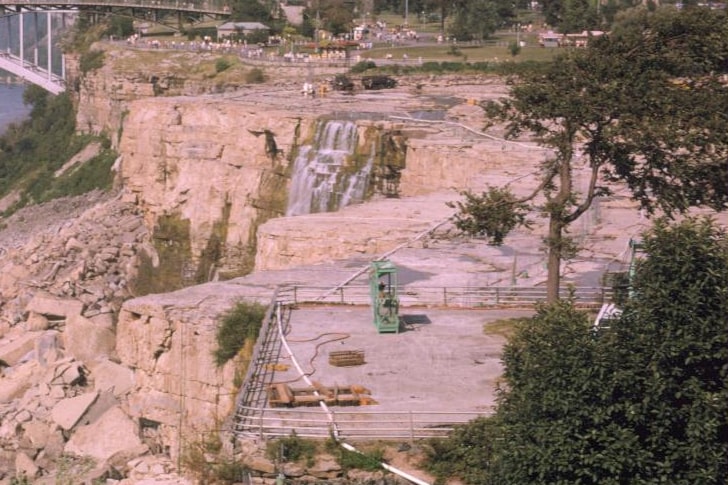
The emptying of the Falls caused a lot of excitement in the region, as well as some anxiety amongst the locals. But there was also a gruesome secret hiding under the rocks. That same Summer, inquisitive visitors spotted something different in the riverbed...
Lying amongst the dry rocks, there was the deceased body of what seemed like a young man. Local authorities were called in to investigate. Was it possible that this man was a cofferdam worker? And for how long had he been lying in the riverbed of the Falls?
A Mystery Yet To Solve
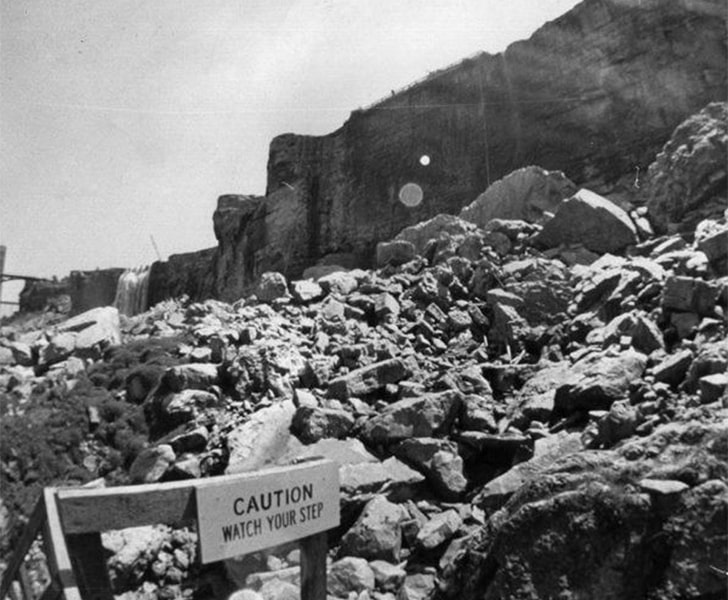
Not much is known about the young man who was recovered from the dry riverbed. However, evidence pointed out to the fact that the man either jumped or fell into the riverbed just one day before the drainage was complete. He was wearing green pants and a similar hued shirt and was not a construction worker.
The discovery of his body inspired the authorities to search for more corpses that could be lying under the rocks. During the investigation, they expected to make a whole series of gruesome findings. After all, the Niagara Falls was known to be one of the U.S.'s most popular suicide locations.
A Second Body Was Found
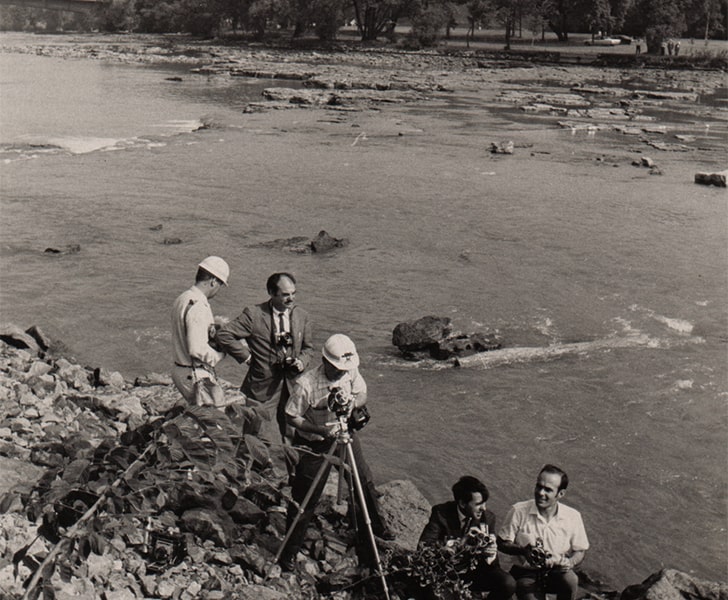
Soon enough, a task force of four policemen was tasked with scanning the riverbed. After successfully recovering the body of the young man, whose name is still unknown, they stumbled upon another body. This time it was a woman, wearing red and white-colored clothes.
Unlike the young man's, the woman's body was severely decomposed, which indicated she had been there for a longer period. The police decided to make an autopsy and start an investigation, even though they knew it was going to be nearly impossible to find the whole truth.
There Are Lots of Unsolved Mysteries in the Falls
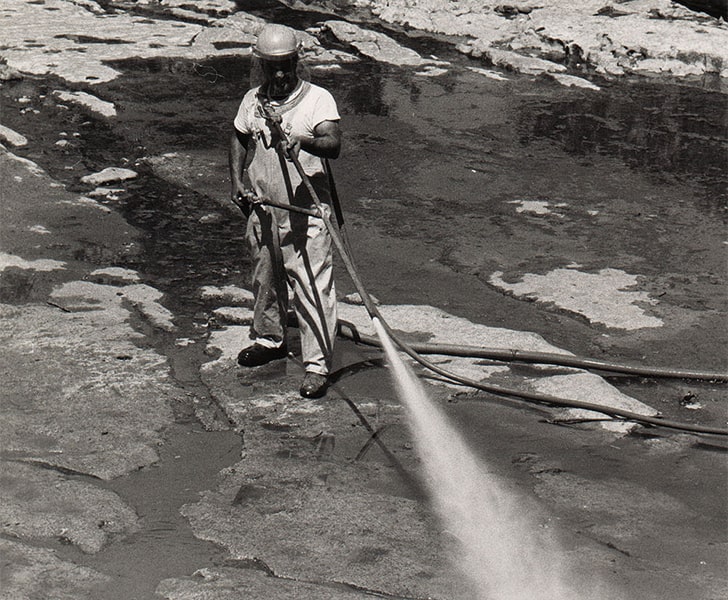
The Niagara Falls is good at impressing visitors, generating electricity, and stimulating the local economy. But the natural wonder is also very good at keeping secrets. The bodies found in the riverbed in 1969 are just two examples of the many gruesome discoveries made in the site throughout the years.
Fatalities are so common in the area that the local authorities were actually surprised to have only found two dead bodies during their expedition. Even today, with the assistance of advanced forensic technology, there are still hundreds of unsolved police cases in the Niagara Falls.
"Forget Me Not"

Even though close to nothing is known about the deceased woman found in 1969, an autopsy was made and an investigation was conducted. The name of the woman was either never known by the authorities, or never revealed to the public. Official records show no information regarding her identity.
But there was one fact that came out, and that still resonates today. The woman was wearing a wedding ring, inside of which the words "forget me not" were inscribed. A timeless symbol of newfound love; could it be that the Niagara Falls was also the place where love goes to die?
The Dark Side of the Falls

More than a place to contemplate and toss coins, Niagara Falls is the location tens of people chose to die every single year. It's a dark truth, but nonetheless a fact. In the 1960s, just like today, the Falls witness up to 40 deaths every year, most of which are considered to be suicides.
Iconic spots like the Falls have a gruesome tendency to attract desperate people. Other recurrent suicide locations around the world include the Golden Gate Bridge, in California, the London Underground, the West Gate Bridge, in Melbourne, or the infamous Aokigahara forest, in Japan.
More Than Just Suicides
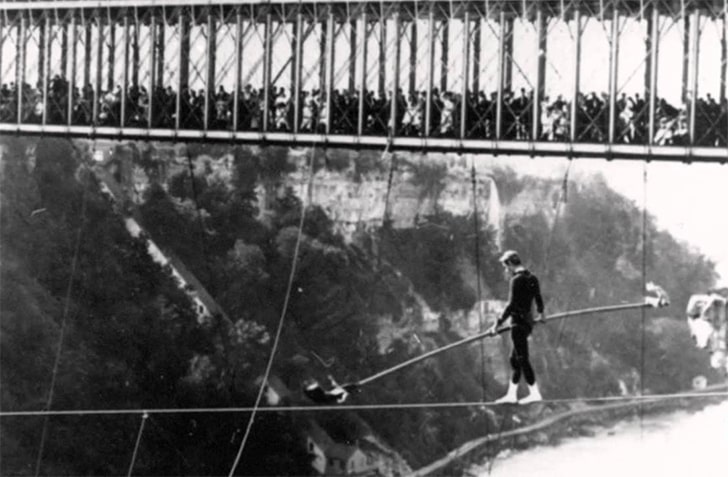
Regardless of being a safe place to visit, the Niagara Falls have also witnessed their share of tragic accidents. From tourists who are recklessly trying to get the perfect selfie, to occasional slips and falls, it is estimated that hundreds of people have accidentally lost their lives in one of the three iconic cliffs of the Falls.
But there's another group of people going over the top near the Canadian-American border: extreme adventurers. Plenty of fearless men and women have tested the limits of their luck by attempting the craziest stunts at the Niagara Falls since the beginning of the 19th century.
America's Most Dangerous Extreme Sport?
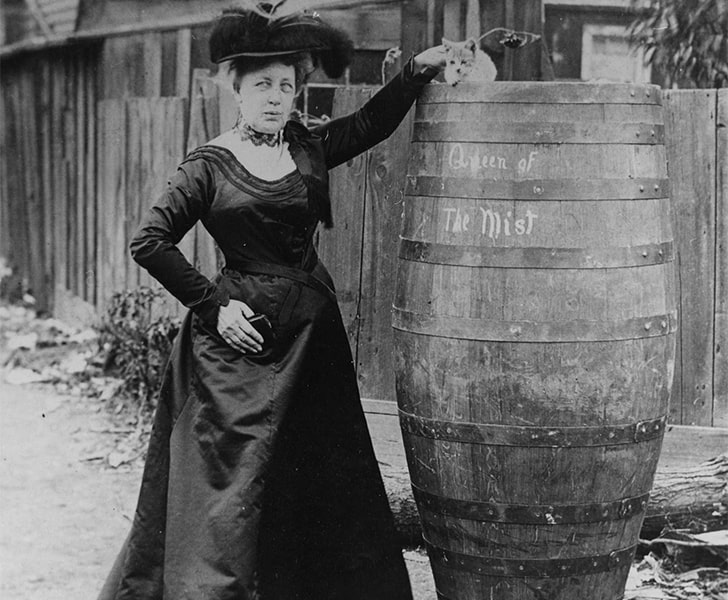
Even though it seems like something coming straight out of a bad action movie, getting yourself inside a barrel and rolling down the Niagara Falls was actually a thing. The stunt was reportedly attempted by many, with the most successful survival being the adventurous American teacher Annie Edson Taylor.
On October 24th of 1901, she became the first person ever to survive the trip. Her feat was motivated by financial reasons, but she never really made money out of the stunt. However, she did make it to the history books. Her advice to her fellow adventurers? "I would caution anyone against attempting the feat".
Others Were Not So Lucky
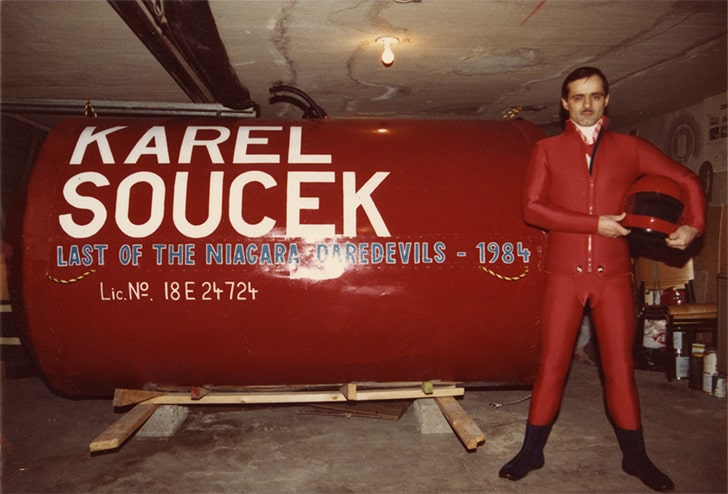
Most recently, Canadian stuntman Karel Soucek reprised Annie Edson Taylor's feat with his own custom-made barrel. While he made it through the Falls, he died in the following year, attempting the same stunt at the Houston Astrodome.
Even crazier was the case of the canoeist Jesse Sharp. In 1990, the over-confident adventurer made dinner reservations before attempting to go down the falls in nothing but a canoe! He decided not to wear a helmet nor a life jacket. Sadly, but unsurprisingly, he was never seen again and his body was never recovered.
Meanwhile, Work Continued As Usual
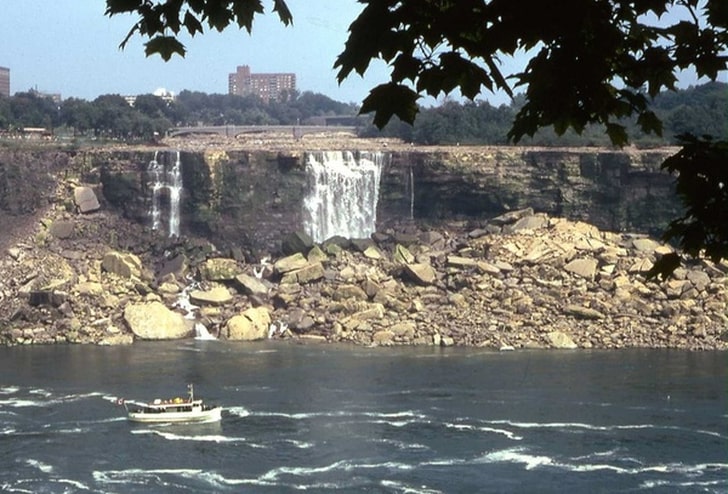
While the police did their best to investigate the origin of the two dead bodies, the authorities continued their plan to preserve the Falls and get rid of the massive talus deposit. Fortunately, they were not bothered by outrageous stunt attempts during that hardworking Summer.
It was now time to get rid of the loose rocks stranded at the riverbed and the bottom of the cliffs. This was not only important to maintain the Falls, but also to ensure the safety of the workers and investigators, by avoiding any unwanted accidents or unexpected rock slides.
The Sprinklers Were Also Placed in Order
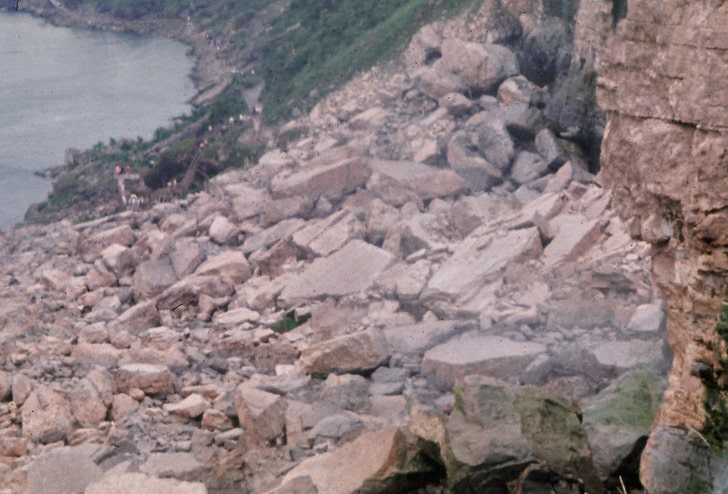
While workers were placed in suspending cages and cranes to remove the loose rocks, the sprinkler system was put into motion. It was designed to keep the upper layer of shale moist and avoid erosion. But wasn't water going to erode the rocks even further?
Even though water is considered to be one of the most common sources of rock erosion, it has a very slow effect, which changes can sometimes only be perceived after millions of years. In this case, allowing the rock to dry would be more dangerous than keeping it wet, as this significant change would lead to a rapid increase in erosion.
The Locals Never Missed a Beat
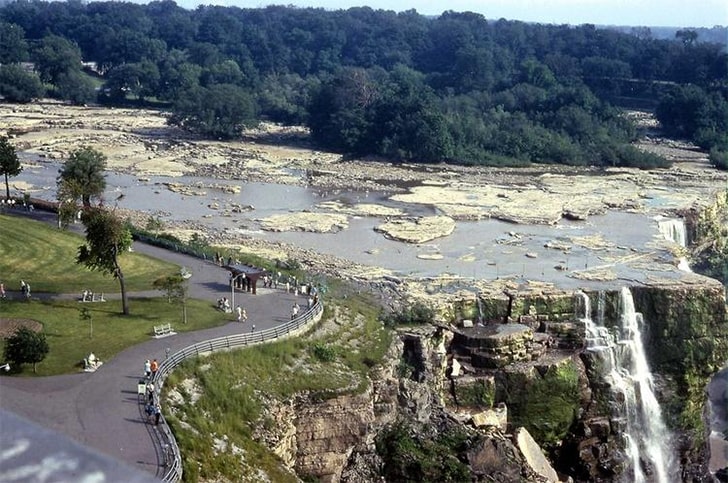
After getting rid of the loose rocks, the diligent workers started testing the absorbency levels of the Falls' surface. Meanwhile, the locals gathered to check on the progress of the work and to take a fresh look at the now water-free cliff of the Falls.
Although unrecognizable, it was nonetheless a beautiful sight. For the first time in tens of thousands of years, the splendorous cataract was as if naked, showing its true colors. And soon enough, the tourists would have a chance to take an even closer look at the beautiful cliff.
A New Platform For the Visitors
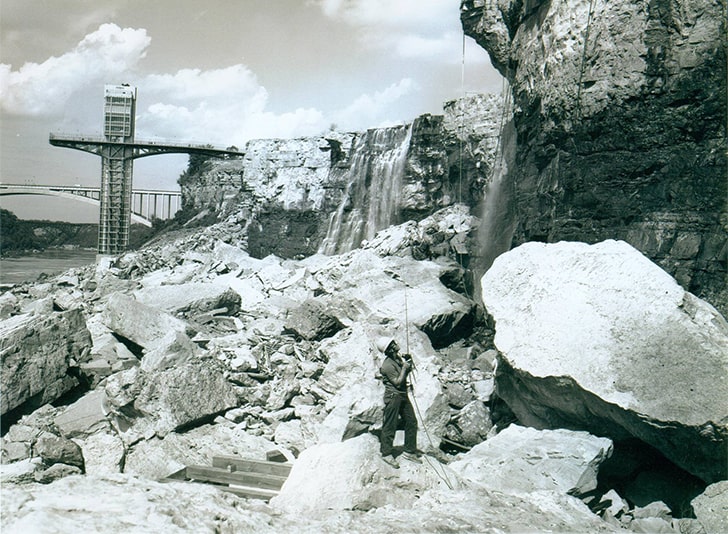
Whether it was by popular demand or due to an autonomous decision, the workers of the Niagara Falls did not forget that they were operating in one of the world's most popular tourist sites. By the 1st of August, they opened up the riverbed to the public, who was now able to roam safely through the site, thanks to a newly-built walkway.
The walkway was meant to attract some tourists to the Canadian-American border and proved to be very popular. The number of tourists was still lower than usual, but, remarkably, the workers found the time to consider the needs of the public.
Bad News Ahead
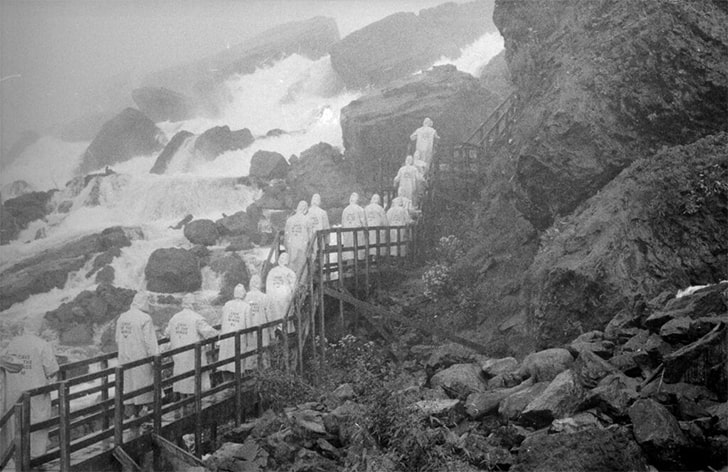
The walkway also proved useful to the researchers. Geological experts were called on the site on August 19 to take a close look at the talus. They needed to gather all the information they could before deciding on what to do next. To do so, they drilled deep holes in the rocks.
The initial plan was very clear: getting rid of the talus seemed like the right thing to do. But as researchers learned more about the importance of the talus, that scenario became increasingly unlikely. It seemed like the talus was more important to the Falls than the experts had initially predicted.
Was It All For Nothing?
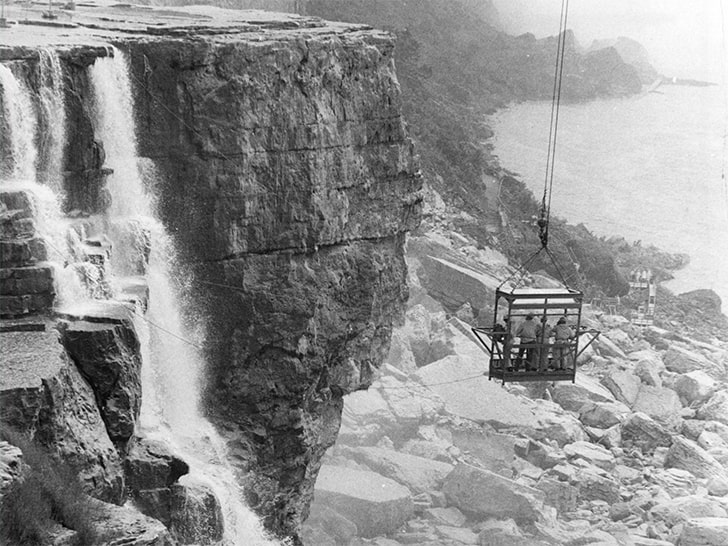
Shockingly, the plan to remove the talus from the Falls was quickly put aside. Engineers studying the location concluded that the talus played a vital role in securing the structure of the cliff. Having it removed would be far too dangerous and could lead to the permanent destruction of the Falls.
Plan A had failed. But there was no way the American Government was going to let all their efforts be in vain. The engineers were tasked with devising an alternative solution. For a while, the idea of building a permanent dam was put on the table. But was it viable?
Going With Plan C
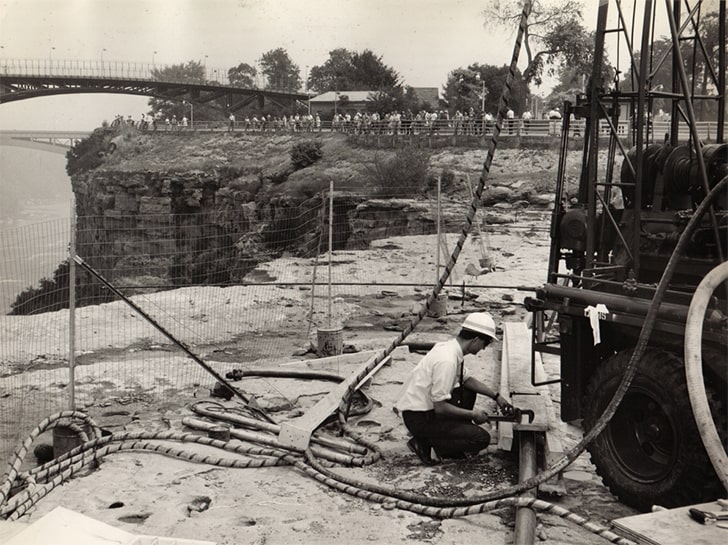
Under the inquisitive eye of the surrounding crowd, the workers, researchers, and engineers of the Niagara Falls studied the option to build a permanent dam on the site. But it became clear that doing such would significantly reduce the flow of water in the Falls.
Building a dam would endanger the long-term survival of the cataract, and limit its impressive visual power in the short-term. It seemed like plan B was also not viable! With no dam and with no alterations to the talus formation on sight, what could they do?
Doing the Best They Can
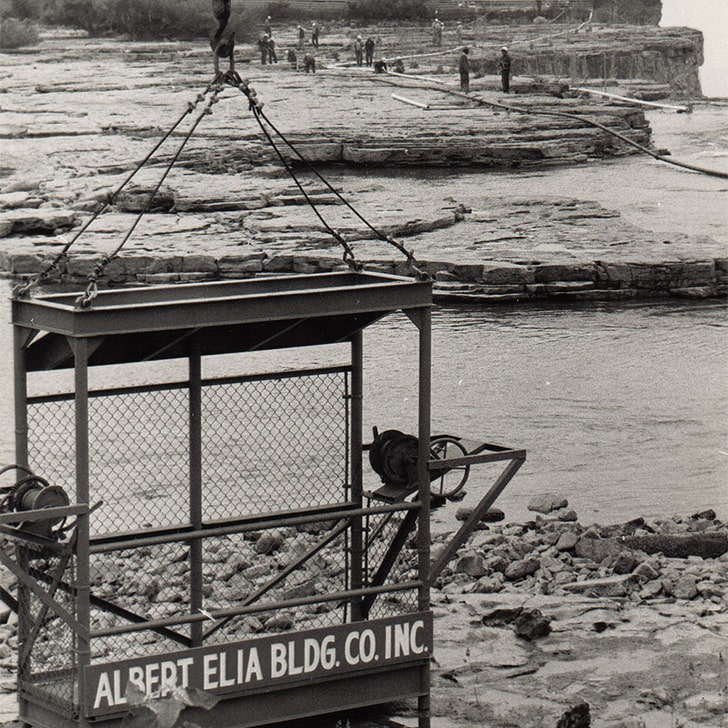
Unfortunately, the whole drainage of the Falls revealed that the talus was surprisingly essential to its existence. Without any other options, the brave workers of the Albert Elia Construction Company proceeded with plan C. The idea was to make the most out of the opportunity to build a network of stabilizing bolts, anchors, and cables.
The entire apparatus was built over the course of six months and had a significant impact on the safety and preservation of the Niagara Falls. The newly-installed infrastructure was meant to keep the mighty Niagara Falls stable and conserved for the next few centuries.
Back Before Christmas
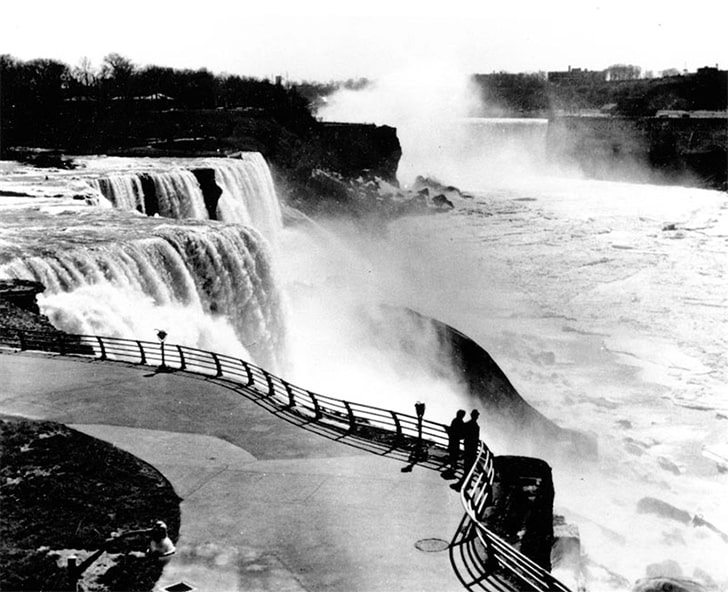
After over six months of hard work, the Niagara Falls returned to its full glory in November. One month before Christmas, the mighty natural wonder was once again a splendorous sight of running water, a unique display of the relentless power of nature.
All of a sudden, it seemed as though nothing had happened. The temporary cofferdam was destroyed with dynamite and the work of the IJC was considered done. But while it seemed like everything was the same, the long-term survival of the Niagara Falls was now guaranteed, and its structure was stronger than ever.
Mankind Leaves Its Mark
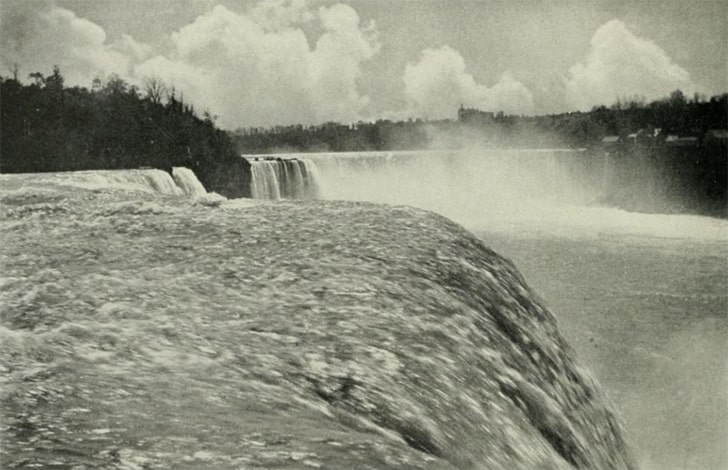
Although it might seem like the Niagara Falls are an ever-lasting wonder of the natural world, they are more fragile than it appears. A man-made structure was enough to dry them out in 1969, but the Falls were feeling the consequences of human activity ever since the early 19th century.
Both the booming industrial exploration and the constant tourist activity took a heavy toll on the Niagara Falls. The giant cliffs sitting at the border are actually now very different from the ones the Europeans found in their early American explorations, over 300 years ago.
The Industrial Debate
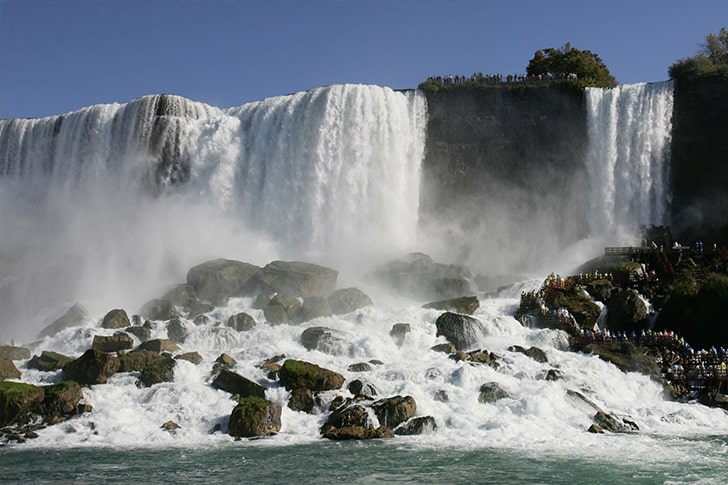
A popular tourist attraction since it first was discovered, the Niagara Falls was losing part of its natural beauty. According to many, this was caused by the associated industries. A powerful source of electricity to the neighboring cities, should the Falls be preserved, or continue to be explored?
The debate is as old as the industrial activity itself. While some believe nature should not be extensively explored by humans, others are convinced that the powers of nature should be at the disposal of society. But was it true? Was the industrial activity truly menacing the natural beauty of the Falls?
Industrialists Made Their Case
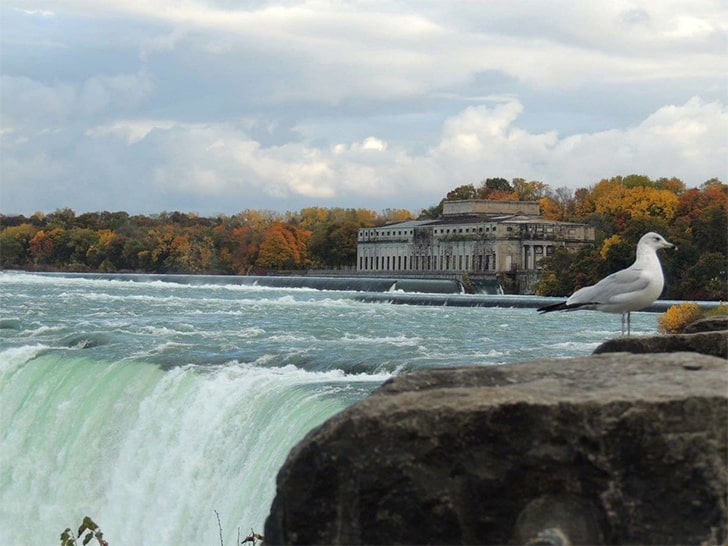
The argument made by the industrialists was that their electrical plants were, in fact, helping to converse the Niagara Falls. By diverting a percentage of the water that ran through the cliffs, they were reducing the natural erosion. Thus, they were contributing to the long-term preservation of the popular tourist attraction.
Additionally, some industrialists have pointed out that tourism was actually more responsible for the decline of the natural beauty of the Falls than the electrical plants. To meet the needs of millions of visitors, countless small businesses were settled in the area, contributing to a significant increase in pollution.
Working Together
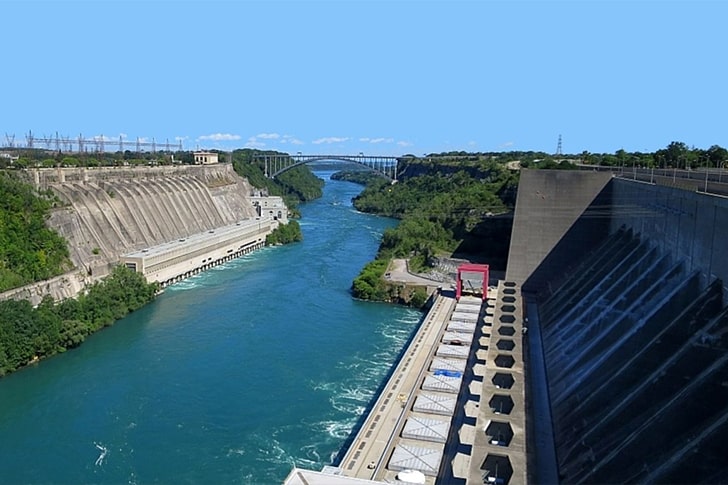
The electrical potential of the Falls was explored by both sides of the border. Both the Canadian and American industrialists wanted to continue to profit and generate electricity on the site. But at the same time, they were aware that their impact on the beauty of the Falls should be as minimal as possible.
To preserve the natural beauty of the tourist attraction, both sides have decided to work together. Soon enough, they reached an agreement. Their goal was to meet the critics halfway, by finding a way to continue generating power without interfering with the tourist potential of the Niagara Falls.
It's All About the Schedule
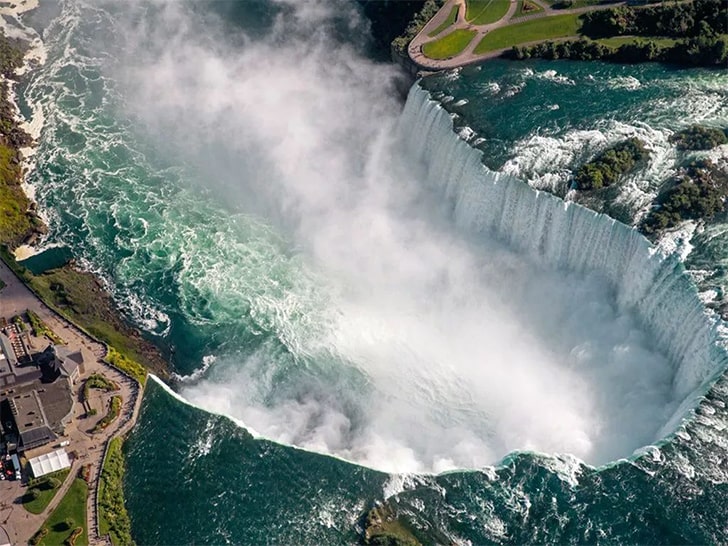
The Canadian and American industrialists realized that, during part of the day, there was almost nobody looking at the Falls. The tourist activity followed a tight schedule. There were no tourists on the site at night, and there was also a significant decrease in visitors during the year's coldest months.
Their solution was to increase the activity of the plants during nighttime and off-season months. This way, their impact on the tourist industry would be almost unnoticeable. But they went even further, deciding to artificially improve the "natural" beauty of the Horseshoe Falls.
It Worked!

The plan of the industrialists seemed to work wonderfully. The Niagara Falls has continued to be one of the world's most popular tourist attractions, and the water flow is still strong enough to make the hearts of the visitors beat faster.
Few people are aware that a great percentage of the streaming water is diverted by the Canadian and American electrical plants. Co-existing in perfect harmony, the electrical and touristic businessmen working at the border have managed to peacefully explore the Falls. Together, they have continued to make the most out of one of the most impressive natural sights in the whole American continent.
But Not Everything is Going According to Plan

While the day-to-day at the Niagara Falls runs as smoothly as always, some of the infrastructures designed to receive the visitors and serve the locals have been aging dangerously. The bridges between the popular Goat Island and the mainland are the most worrying examples.
Built over 100 years ago, these old stone bridges are not considered safe anymore and need to be replaced. The idea of restoration was put on the table, but experts have concluded that the two structures are so outdated that restoration is no longer a viable option.
Back to 1969?

In 2016, only a few decades after the 1969 drainage, it became evident that it was necessary to drain the American Falls once again. With the Goat Island bridges needing to be replaced immediately, it was just a matter of time until a new cofferdam was developed on the site.
A commission of engineers decided to schedule a historical second emptying of the Falls in 2019. But unfortunately, the whole project was postponed and is still awaiting funding. The commission was unable to collect the necessary $30 million they needed to complete the installation of the new bridges.
In the To-Do List

We have not witnessed the suspension of the American Falls in 2019. But the project will have to happen eventually. The news has already stirred public opinion. Some believe that the drainage will be beneficial to tourism. Others are curious about how many bodies will be discovered this time around.
Either way, the goal continues to be the same: to secure and maintain one of the world's most beautiful and inspiring natural wonders. And meanwhile, the best we can do is relax and contemplate its beauty, just like our ancestors did more than 300 years ago.
